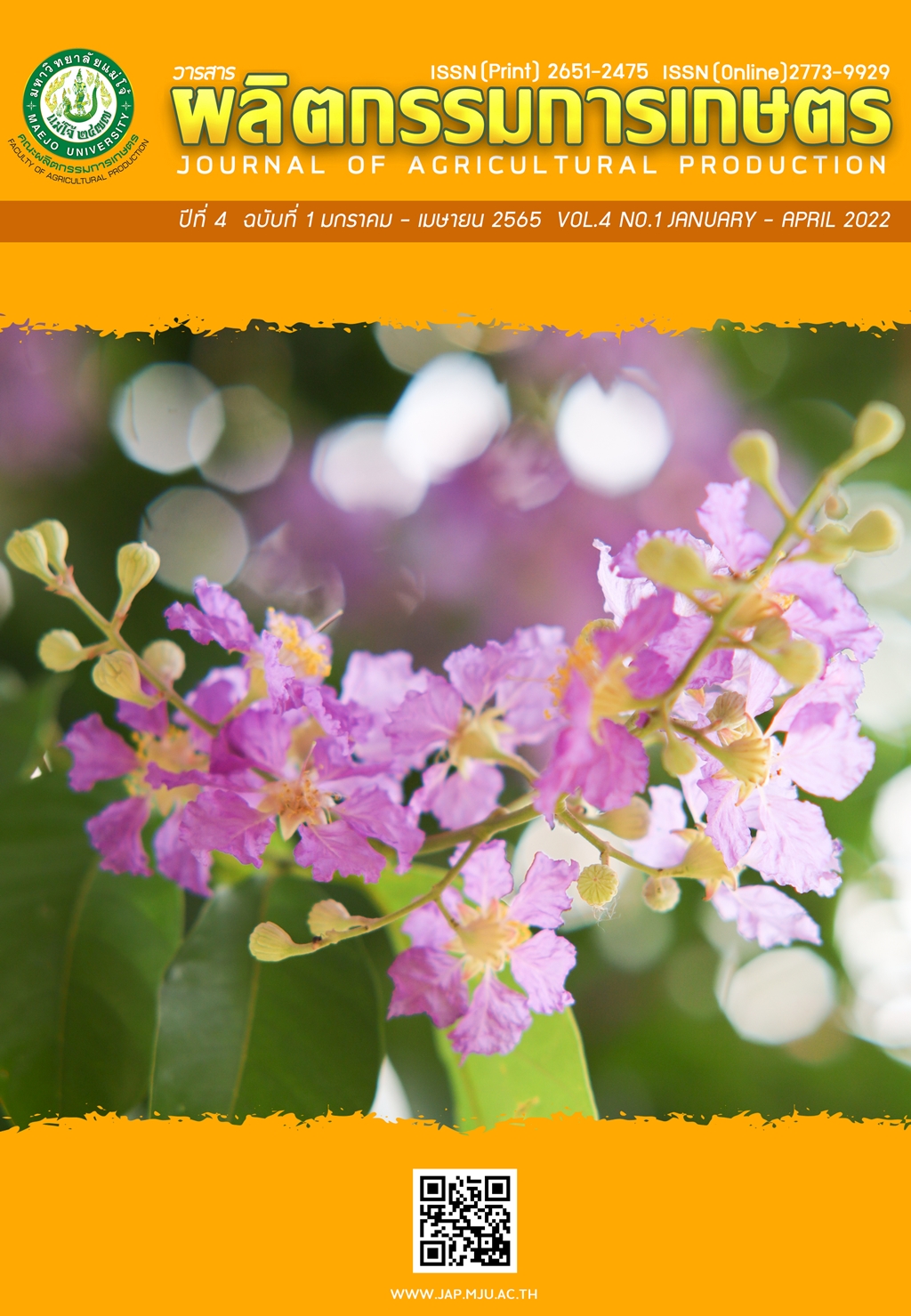การเปรียบเทียบวิธีการสกัดและอัตราส่วนของสารสกัดที่แตกต่างกัน ต่อน้ำหนักสารสกัดหยาบ ปริมาณสารประกอบฟีนอลิก และฟลาโวนอยด์ ในกระชายดำ
Main Article Content
บทคัดย่อ
งานวิจัยนี้ได้เปรียบเทียบวิธีการสกัดที่แตกต่างกัน (การแช่หมัก อัลตราโซนิค และไมโครเวฟ) ด้วยอัตราส่วนของเอทานอลต่อน้ำ (100:0, 80:20, 60:40, 40:60, 20:80 และ 0:100) ต่อน้ำหนักสารสกัดหยาบ สารประกอบฟีนอลิกรวม และปริมาณสารฟลาโวนอยด์ในกระชายดำ ผลศึกษาพบว่า น้ำหนักสารสกัดหยาบ สารประกอบฟีนอลิกรวม และปริมาณสารฟลาโวนอยด์ในกระชายดำ มีความแตกต่างกันอย่างมีนัยสำคัญทางสถิติ (P<0.05) ต่อวิธีการสกัดด้วยอัตราส่วนของเอทานอลต่อน้ำต่างกัน โดยน้ำหนักสารสกัดหยาบมีปริมาณมากที่สุด (12.23±1.03%) เมื่อทำการสกัดด้วยวิธีการแช่หมัก และใช้เอทานอลต่อน้ำที่อัตราส่วน (60:40) ในขณะที่สารประกอบฟีนอลิกรวม และสารฟลาโวนอยด์มีปริมาณมากที่สุดเมื่อทำการสกัดด้วยวิธีไมโครเวฟ โดยปริมาณสารประกอบฟีนอลิกรวมมีค่าสูงที่สุด (65.60±4.62 มคก.สมมูลของกรดแกลลิกต่อ มก.สารสกัดหยาบ) เมื่อสกัดด้วยเอทานอลต่อน้ำที่อัตราส่วน 60:40 นอกจากนี้เมื่อใช้เอทานอลและน้ำที่อัตราส่วน 100:0 จะสกัดสารฟลาโวนอยด์สูงที่สุด เท่ากับ 93.43±9.78 มคก.สมมูลของเคอร์ซิตินต่อน้ำหนักสารสกัดหยาบ 1 มก.
Article Details

อนุญาตภายใต้เงื่อนไข Creative Commons Attribution-NonCommercial-NoDerivatives 4.0 International License.
เอกสารอ้างอิง
กาญจนา นาคประสม จตุรภัทร วาฤทธิ์ อุมาพร อุประ หยาดฝน ทนงการกิจ และ นักรบ นาคประสม. 2560. สภาวะที่เหมาะสมในการสกัดสารประกอบฟีนอลิกรวมจากดอกบัวหลวง โดยใช้เทคนิคสกัดด้วยไมโครเวฟ. วารสารวิทยาศาสตร์ มข. 45(2): 328-342.
Azuma, T., Y. Tanaka and H. Kikuzuki. 2008. Phenolic glycosides from Kaempferia parviflora. Phytochemistry. 69(15): 2743-2748.
Baghdikian, B., A. Filly, A.S.F. Tixier, E. Petitcolas, F. Mabrouki, E. Chemat, and E. Ollivier. 2016. Extraction by solvent using microwave and ultrasound-assisted techniques followed by HPLC analysis of Harpagoside from Harpagophytum procumbens and comparison with conventional solvent extraction methods. CR. CHIM. 19(6): 692-698.
Chang, C. H., H.Y. Lin, C.Y. Chang and Y.C. Liua. 2006. Comparisons on the antioxidant properties of fresh, freeze-dried and hot-air-dried tomatoes. J. Food. Eng. 77: 478-485.
Chivapat, S., P. Chavalittumrong, A. Attawish and A. Rungsipipat. 2004. Chronic toxicity study of Kaempferia parviflora Wall ex. extract. Thai. J. Vet. Med. 40(4): 377-383.
Dent, M., V.D. Uzelac, M. Penic, M. Branic, T. Bosiljkov and B. Levaj. 2013. The effect of extraction solvents, temperature and time on the composition and mass fraction of polyphenols in Dalmatian Wild Sage (Salvia officinalis L.) extracts. Food. Technol. Biotechnol. 51(1): 84–91.
Do, Q.D., A.E. Angkawijaya, P.L. Tran-nguyen, L.H. Huynh, F.E. Soetaredjo, S. Ismadji and Y.H. Ju. 2014. Effect of extraction solvent on total phenol content, total flavonoid content, and antioxidant activity of Limnophila aromatic. J. Food. Drug. Anal. 22(3): 296-302.
Eungpinichpong, W., U. Chatchawan, B. Sripanidkulchai, S. Arunpongpaisal and W. Chompoopan. 2018. Effects of Kaempferia parviflora on physical and psychological stresses in audits. Int. J. GEOMATE. 15(50): 26-31.
Golmakani, M.T. and K. Rezaei. 2018. Comparison of microwave-assisted hydro distillation with the traditional hydro distillation method in the extraction of essential oils from Thymus vulgaris L. Food Chemistry. 109(4): 925-930.
Hikmawanti, N.P.E., S. Fatmawati and A.W. Asri. 2021. The effect of ethanol concentrations as the extraction solvent on antioxidant activity of Katuk (Sauropus androgynus (L.) Merr.) leaves extracts. IOP Conf. Ser. Earth Environ. Sci. 755: 1-7.
Kkeiman, M., K.A. Ryu and A.P.E. Kahn. 2016. Determination of factors influencing the wet etching of polydimethylsiloxane using tetra-n-butyl ammonium fluoride. Macromol. Chem. Phys. 217: 284-291.
Lianfu, Z. and L. Zelong. 2008. Optimization and comparison of ultrasound/microwave assisted extraction (UMAE) and ultrasonic assisted extraction (UAE) of lycopene from tomatoes. Ultrason. Sonochem. 15: 731-737.
Liu, J.L., L.Y. Li and G.H. He. 2016. Optimization of microwave-assisted extraction conditions for five major bioactive compounds from flos sophorae immaturus (Cultivars of Sophora japonica L.) using response surface methodology. Molecules. 21(296): 1-27.
Mandal, V., Y. Mohan and S. Hemalatha. 2007. Microwave assisted extraction – An innovative and promising extraction tool for medicinal plant research. Pharmacogn. Rev. 1(1): 7-18.
Masota, N.E., G. Vogg, E. Heller and U. Holzgrabe. 2020. Comparison of extraction efficiency and selectivity between low-temperature pressurized microwave-assisted extraction and prolonged maceration. Arch. Pharm. 353(10): 1-11.
Prommajak, T., S. Surawang and N. Rattanapanone. 2014. Ultrasonic-assisted extraction of phenolic and antioxidative compounds from lizard tail (Houttuynia cordata Thunb.). Songklanakarin. J. Sci. Technol. 36(1): 65-72.
Rabeta, M.S. and M. Vithyia. 2013. Effect of different drying methods on the antioxidant properties of Vitex negundo Linn.Tea. Int. Food. Res. J. 20(6): 3171-3176.
Rosa, G.S., S.K. Vanga, Y. Gariepy and V. Raghavan. 2019. Comparison of microwave, ultrasonic and conventional techniques for extraction of bioactive compounds from olive leaves (Olea europaea L.). Innov. Food. Sci. Emerg. Technolies. 58: 1-8.
Saokaew, S., P. Wilairat, P. Raktanykan, P. Dilokthornsakul, T. Dhippayom, C. Kongkaew, R. Sruamsiri, A. Chuthaputti and N. Chaiyakunapruk. 2017. Clinical effects of krachaidum (Kaempferia parviflora): A systematic review. Evid. Based. Complement. Alternat. Med. 22(3): 413-428.
Siramon, P., T. Wongsheree and S. Yuadyong 2020. Ultrasound-assisted extraction of phenolic compounds from coconut endocarp and its radical scavenging activity. Naresaun. Phayao. J. 13(3): 22-28.
Sudwan, P., K. Saenphet, S. Saenphet and S. Suwansirikul. 2006. Effect of Kaempferia parviflora Wall. Ex. Baker on sexual activity of male rats and its toxicity. Southeast Asian J. Trop. Med. Public Health. 37(suppl 3): 210-215.
Sutthanut, K., B. Sripanidkulchai, C. Yenja and M. Jay. 2007. Simultaneous identification and quantitation of 11 flavonoid constituents in Kaempferia parviflora by gas chromatography. J. Chromatogr. A. 1143: 227–233.
Ueda, Y., N. Apiphuwasukcharoen, S. Tsutsumi, Y. Matsuda, V. Areekul and S. Yasuda. 2019. Optimization of hot-water extraction of dried yacon herbal tea leaves: enhanced antioxidant activities and total phenolic content by response surface methodology. Food. Sci. Technol. Res. 25(1): 131-139.
Vinatoru, M., J. T. Mason and I. Calinescu. 2017. Ultrasonically assisted extraction (UAE) and microwave assistedextraction (MAE) of functional compounds from plant materials. Trends. Analyt. Chem. 97: 150-178.
Wongsrikaew, N., H. Kim, K. Vichitphan, S.K. Cho and J. Ha. 2012. Antiproliferative activity and polymethoxyflavone composition analysis of Kaempferia parviflora extracts. J. Korean. Soc. Appl. Biol. Chem.55: 813−817.
Yenjai, C., K. Prasanphen and S. Daodee, V. Wongpanich and P. Kittakoop. 2004. Bioactive flavonoids from Kaempferia parviflora. Fitoterapia. 75(1): 89-92.
Zhang, Q.W., L.G. Lin and W.C. Ye. 2018. Techniques for extraction and isolation of natural products: a comprehensive review. Chin. Med. 13(20): 1-26.


